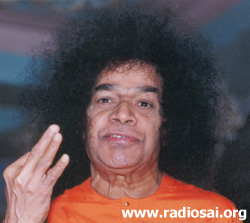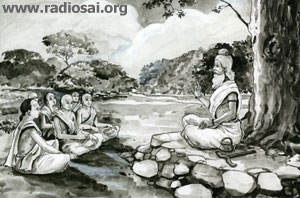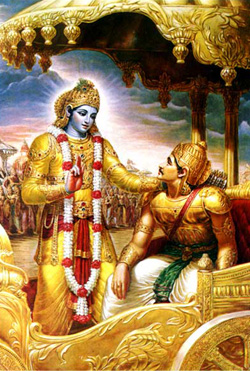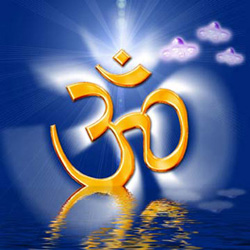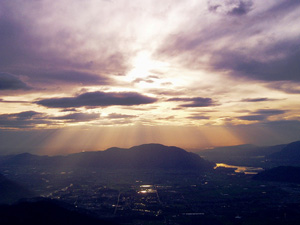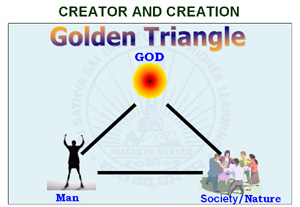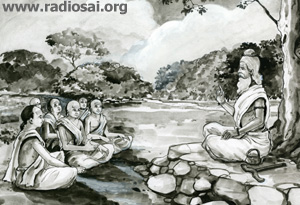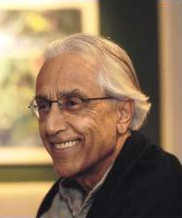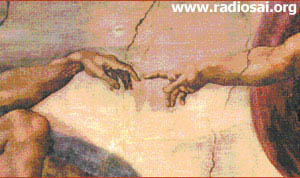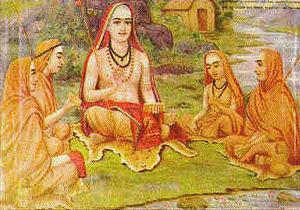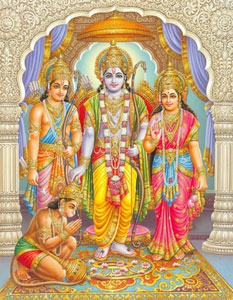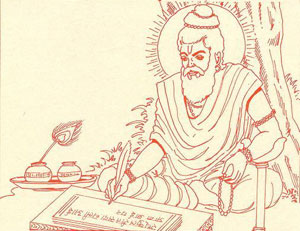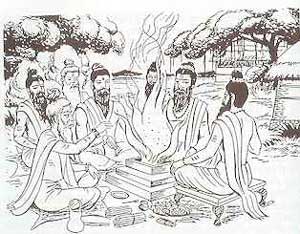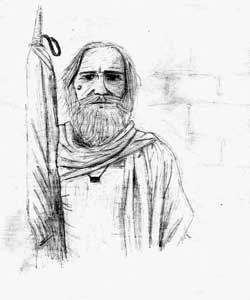renuka
Well-known member
MUSINGS FROM PRASHANTHI NILAYAM
CONCERNING THE VEDAS – 02
THE VEDAS - THEIR EVOLUTION AND SIGNIFICANCE
CONCERNING THE VEDAS – 02
THE VEDAS - THEIR EVOLUTION AND SIGNIFICANCE
By Prof. G Venkataraman
The Vedas are the most ancient among the world’s scriptures. They are a vast storehouse of wisdom. Manu has declared, “Everything is derived from the Vedas.” The Vedas are immeasurable, unrivalled, and filled with Bliss. The word Veda is derived from the root word Vid, which means to know. Knowledge of the Supreme is Veda.
The Vedas – A collection of Divine Revelations
The Vedas consist of hymns, thousands and thousands of them. They represent an ocean to which countless Sages have contributed, going back to a period when there was only the spoken language and no script. The hymns of the Vedas represent thoughts and revelations that came to the Sages of yore during their meditations. These revelations were in the form of hymns, which the Sages transmitted to their disciples. Thus it was that they were passed from generation to generation. For centuries, all this happened entirely by word of mouth. The written version came much later. Thus the growth of the Vedas is like a series of small streams joining to form tributaries that feed big rivers, the rivers all finally merging into the ocean. This analogy is very apt, because the water that the streams get is from the rain, whose source is really the ocean. In the same way, the revelations that the Sages had were from the Divine; and the Ocean made up by the collection of revelations that constitutes the Vedas, is also Divine.
The Sound Aspect of Vedic Hymns – It’s Significance
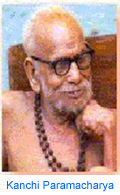
Vedas must be chanted with grandeur so that the sound can be properly heard. Vedic Mantras not only produce beneficial vibrations in the pulse of the one who chants them properly, but also similar vibrations in those who may hear them. Since it is spread in the atmosphere, it ensures wellbeing here and hereafter. The outstanding feature of the Vedas lies in the fact that the sound of the Mantras by itself when chanted has a meaning, apart from the words themselves, which too are pregnant with significance.
The sound aspect has been preserved from very ancient times and that is something remarkable. The sound aspect is linked intimately to the words, and the two, namely the sound and the word together have been so intertwined that over time, Vedic hymns have defied corruption and mutation. This is an important point and needs some reflection.
Let us take any language, including English. All languages have evolved. If say, an Englishman who lived fifteen hundred years ago were to suddenly appear before us and start speaking, I am sure most of us would not be able to understand what he is saying. The words would be different and so also the style. This is true of almost all languages. Languages evolve with time, these days over even short periods, but the Vedic language has remained invariant over the several thousand years during which the Vedas evolved.
How Have the Vedic Hymns Remained Uncorrupted
I once asked a scholar how this was possible since languages have all evolved the world over. The answer he gave was interesting. He said that the Vedic hymns have remained uncorrupted because of the sound aspect. They had a particular metre and when chanted, they had a certain completeness of their own. Any mutation or distortion of the words would severely disturb the sound aspect, and this disturbance could be easily detected. Since the sound aspect was dominant, corruption could be spotted and eliminated immediately; this is how, I was told, the pristine purity of the Vedas had been preserved. Sounds plausible I would say.
Anyway, the fact of the matter is that the way the Vedas are chanted now, as, for example, in Swami’s presence everyday during Darshan, is the same as the way they were chanted thousands of years ago. I must of course qualify this by adding that there are some special schools of Vedic chanting but I am not considering that here; rather, I am confining myself to the standard method of chanting.
Just to make myself clear, let us say there is a Vedic Pandit from the East Godavari District in Andhra Pradesh and another from Kerala. East Godavari District and Kerala are at least a thousand kilometres apart. The respective Vedic scholars would have imbibed their tradition from their ancestors in those two widely separated parts of the country, parts, which, until recently, did not have good communication between them.
Suppose these two scholars meet and one of them starts chanting say the Taittriya Upanishad. The other would have absolutely no difficulty in joining the first scholar in the recitation. That is because the recitation tradition is the same for both, and that is because the recitation is fixed and has remained invariant through the ages. I hope you get the point. If you reflect on it, you would find this aspect unique.
Swami On Why The Vedas
Let me now go back for a minute to the Divine revelation aspect. Such revelations are not as rare as people might imagine, and have occurred to people in various places at various times in history. Indeed, even in science, such revelations have occurred. Of course, historians of science would not record it that way. They would instead say that Archimedes had a flash of discovery, Einstein had a flash of intuition, and so on. However, these flashes are nothing but the revelation of the Divine, maybe in relation to the material world, but revelations nonetheless.
Back to Swami and let us find out what more He has to say about the Vedas. Here is a quote:
The Vedas took form, only to demonstrate and emphasise the existence of God. The Veda is a collation of words that are the Truth, which were visualised by sages who had attained the capacity to receive them into their enlightened awareness. In reality, the Word is the very Breath of God, the Supreme Person. The unique importance of the Veda rests on this fact.
Why are the Vedas called Sruthis
Because the Vedas originally existed only in sound form, they are sometimes referred to as Sruthi. In scriptures, Sruthi means that which is heard. The real reason for giving the name Sruthi to the Vedas is that Cosmic Vibrations which are inaudible and cannot be seen were heard by the mediating Sages as sound. That is also one of the reasons why the sound aspect is given so much importance. Great stress is therefore laid by the teachers of Vedas on the correct pronunciation of the word and the intonation while chanting. Listeners who have heard the extended Vedic chants by students before Swami, would be able to appreciate what I mean.
The ancients of India devised elaborate recitation drills so that through the ages, the chants would remain the same, without mutation and corruption. This is something remarkable, and I am not sure if there is any other comparable example.
The Structure of The Vedas
I must now say something about the structure of the Vedas. It is usually said that there are four Vedas. Yes there are, but this classification came after several thousands of years. Before that, it was, shall I say, a period of discovery? Revelations came to people belonging to different times, and these were encapsulated into Vedic hymns. There were thousands and thousands of hymns but unfortunately, most of them have been lost in time. What has survived is only a small part. Even so, they are not only grand in themselves, but tell, in their own way, the story of the evolution of human thought. I shall come to that aspect a little later but for now, I shall stay with the topic concerning the structure of the Vedas.
Today we recognise four Vedas, the Rig Veda, the Sama Veda, the Yajur Veda and the Atharvana Veda. Apparently, it was Sage Vyasa who made the compilation and classification of Vedic hymns in this manner. It is customary to identify in each Veda, three portions known respectively as: Samhita, Brahmana and Aranyaka. Thus, the Rig Veda has its own Samhita, its own Brahmana and its own Aranyaka. The same holds for the other three Vedas also.
The Division within Each Veda
Now what do these three portions signify? Why this division? That is the question I shall address next. In a sense, the three portions are indicators of evolution of Vedic thought. The word Samhita means that which has been collected and arranged. The Samhita portion of a given Veda contains the Mantras belonging to that Veda, arranged in a systematic manner. These Mantras comprehensively convey the main objective or the purpose of that particular Veda. The Vedic Mantras that we often hear come mainly from the Samhitas.
Turning next to the Brahmanas, these spell out how certain rituals ought to be performed. About the Brahmanas, Swami has this to say:
The Brahmanas constitute an important part of the Vedas, and deal with the correct procedures for performing rituals like the Yajnas and Yagas. Being ceremonial rites for acquiring mundane pleasures, such ceremonies, however, cannot offer Atmananda or the Pure Bliss of the Atma. They can only enhance sensory enjoyment and provide epicurean pleasures, which are intrinsically transient. The search for pure abiding Bliss of the Atma led the ancient Rishis to the solitude of the forests.
This leads me on in a quite natural fashion to the Aranyakas. This word is derived from the word Aranya, which means forest. Thus, the Aranyakas are sometimes referred to as forest books and with good reason. As already pointed in the quote from Swami, neither the Samhitas or the Brahmanas ask a person to give up everything and retire to the forest in order to contemplate on God and focus totally on spiritual development. No doubt chanting Mantras from the Samhitas does promote some purity of mind, but where spiritual development is concerned, they can take a person only so far.
The Aranyakas have a different objective. They are meant for people who wish to reach higher levels of development through intense contemplation and meditation of the Supreme One in His most abstract aspect. The famous Upanishads come at the end of the Aranyakas and represent the quintessence of Vedic Knowledge. As Swami puts it, “Ancient Sages have communicated the spiritual wisdom revealed to them through the Upanishads.”
Evolution Of Vedic Thought – The First Step
The above brief introduction to the Vedas also enables me now to comment on the evolution of Vedic thought. If one goes carefully through the Vedic texts that span the ages, one can see a clear line of evolution. The very early hymns are in the Rig Veda, and they not only express ancient man’s sense of wonder but also reveal how he identified specific deities like Indra, Agni, Vayu and so on with forces of Nature. About all this, Swami says,
The very first experience in Indian thought is the thrill of wonder. This is expressed in the hymns or Riks found in the Rig Veda. The Riks are all about the deities or the Devas, like Indra, Varuna and so on.
From this we see that the very early seekers did not straightaway understand Brahman, the Ultimate and all that. Like people elsewhere, the ancients of India also were struck with wonder about Nature and all the forces that formed a part of her, like thunder, lightning, wind, rain, etc. They also understood, perhaps in their own imperfect way, that there was a subtle synergy between the various agencies of Nature that promoted the sustenance of life on earth.
Everything from the ant to the elephant was seen as a part of some mysterious Cosmic cycle. And so, the very first thoughts related not only to the inevitable sense of wonder but also to an important question of logic. If there were forces in Nature, there ought also to be agencies that controlled these forces. It is these that were identified as Devas, and the Devas in charge of different departments, shall I say, were given different names like Indra, Agni and so forth. This is what I would call the first level of thought in a long evolutionary process.
It is interesting in passing to note that the Greeks also went through almost a similar thought process. As would be recalled, the Greeks too had a god of fire, a god for this, a god for that and so on. In fact, tribes everywhere had their own spectrum of deities or spirits, be it in Africa or North America. What this shows is that ancients everywhere had the implicit belief that there was something in the Universe more that what one could merely see with the eyes and experience with the senses.
The Second Step – Worshipping the Elements
Having decided that there were Devas who controlled various aspects and forces of Nature, the next task was to worship them and perform various rituals to propitiate them. Thus it was that rituals came into existence, almost soon after the Devas were accepted. Listeners may recall, for example, that Emperor Dasaratha performed a ritual called the Putrakameshti Yaga for having children. By the way, this ritual is sometimes performed even these days by the childless.
So the first step in the evolution process was to identify Devas and worship them. In due course, the more intensive of the Vedic seekers decided to probe further beyond the Devas and concluded, in the first instance, that there must be an overlord for these deities. The deities were like Viceroys, and there must be a Rex or a King who ruled over them. Thus it is that they convinced themselves about a Power superior to the deities. That power was called God.
Now arose an issue. Whom to worship? Some said, “Worship the deities for particular favours, and worship the God who ruled them when the deities were unable to deliver the goods.” Thus in ancient India, many started worshipping Varuna the God of Rain when the monsoon failed but prayed to another God when they wanted progeny or cure from illness and things like that. This is like going to different counters in a bank when one needs different kinds of service.
At this stage, some thinkers said, “Hey wait a minute. Let’s examine this business in some more detail.” They did so and came up with an answer that is best illustrated by using the analogy of a Bank. Just go to, say, the main office of the State Bank of India in Prashanti Nilayam during the working hours. You will find that many customers are seated with the Manager. Often, these are people from overseas who have big deposits in the Bank. They may have things they want to do like withdrawing some money, getting some foreign currency cashed, making new deposits and so forth. For every such activity, there is an assigned person and a counter for conducting the transaction; yet the VIP customer gets all his jobs done simply by sitting with the Manager. In the same way, these profound thinkers in ancient India came to the important conclusion that though there were deities who took care of limited portfolios, all the favours one wants can in fact be granted directly by God who ruled all the Devas, and that there was no need to separately take these issues up with the lesser deities or Devas.
The Final Understanding – The Existence of The Supreme One
In short, step by step, the seekers realised that there is a Supreme One who is beyond this world, beyond the Universe in fact, and beyond Space and Time too. The seekers also realised that this Supreme One who was beyond Space and Time itself, could not be described in words, and could not be cognised by the Mind too. We have heard so many speakers quote this Vedic phrase:
Yato vaache nivarthante aprapya manasachaha.
This phrase refers to Something that is beyond description and even thought.
Space-Time is a curtain that divides the Creator from the Creation. Creation is on this side of the curtain, while the Creator in all His absolute and pristine glory is on the other, so to speak. In short, slowly but surely, the seekers were zeroing on the existence of the curtain and the presence of something Supreme beyond that curtain. That something is God, whose children we all are, irrespective of race, religion, creed or nationality.
The Vedas Are Universal
In this sense, the Vedas are Universal and it is for that reason that Swami makes it a point to draw attention to the Vedas, and NOT because they are Indian in origin.
To repeat, the Vedas focus on a MYSTICAL ETERNAL SOMETHING that is beyond this world, beyond this Universe, beyond Space and Time itself, and is changeless. It is that Something beyond words and even the Mind that the Vedic seers were in quest of, and with good reason too.
Indeed, across the ages, seekers elsewhere too have been engaged in this very quest, though by different means. Einstein was one of them, and he gives expression to this beautifully. Explaining why he pursued Science, Einstein once said:
A knowledge of the existence of Something we cannot penetrate, which only in their most primitive forms are accessible to our Minds – it is this Knowledge and emotion that constitute true religiosity. In this sense, I am a deeply religious man.
Einstein tried to catch a glimpse of Cosmic Infinity through Science while the seekers of the Vedic age sought that very same ETERNITY via the path of devotion and Spiritual inquiry.
Dear Forum Members since article is too long...i put in into 2 post.kindly read the continuation below
Last edited:

